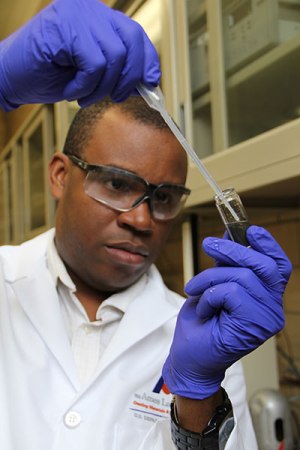Jul 1 2015
Scientists belonging to the Critical Materials Institute, a U.S. Department of Energy Innovation Hub managed by the Ames Laboratory, have discovered a new way to recycle manufacturing waste to recover rare-earth magnetic material and use it to form useful magnets.
One of the ways to minimize the demand of rare-earth magnetic materials, which are limited mined resources, is to develop efficient waste-recovery techniques.
 CMI scientist Ikenna Nlebedim
CMI scientist Ikenna Nlebedim
This economic technique involves the direct reuse of cobalt waste powders as raw material, which is used to produce polymer-bonded magnets with features that match the performance of commercial bonded magnets produced from new materials. Additionally, it can be utilized for manufacturing sintered magnets.
While manufacturing magnets, the grinding and cutting generates waste metal powders and filings known as swarf. Recovery of materials from swarf is essential as it includes expensive rare-earth metals such as neodymium, samarium and dysprosium.
At the early stages of the research, the team only aimed at discovering an efficient technique for isolating and recovering the rare-earth metals for reuse. However Ikenna Nlebedim, CMI scientist stated that along with co-inventor Bill McCallum, he was keen on exploring further.
The first set of magnets produced using the new technique had a magnetic strength of about 11 MGOe (megagauss-oersteds). The team believes that they can further improve on this property by tweaking their technique.
We decided to see if there is a possibility of reusing the swarf itself for magnet manufacturing. We wanted to see if we could save that extra step of metals separation, because it’s not just an extra step, it’s an expensive and time consuming one.
Ikenna Nlebedim
CMI Scientist and Co-Inventor
“If we can optimize the process, this magnet will fit very well in a performance gap that exists between the non-rare-earth magnets and rare-earth magnets,” Nlebedim said. The product thus created will be a better choice in terms of cost-effectiveness for several applications, thereby decreasing the demand for the costly neodymium-iron-boron magnets.
Nlebedim explained that the team plans to explore other avenues for the technology as well as the production of sintered samarium-cobalt magnets, which is a material with higher economic worth than bonded magnets. Nlebedim added that the technique also achieves its primary aim of separating rare-earth metals as and when required.
“I think the beauty of this process is that it has direct value to manufacturers of magnets,” said Nlebedim. “They recover their own swarf directly and recycle it themselves. Because it is not recovered from post-consumer products, manufacturers retain quality control of the composition of their materials and can be confident of the grade of their product. From a profit standpoint, this process is very strategically placed to benefit them.”